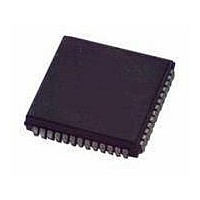MC68711E20CFNE3 Freescale Semiconductor, MC68711E20CFNE3 Datasheet - Page 36

MC68711E20CFNE3
Manufacturer Part Number
MC68711E20CFNE3
Description
IC MCU 8BIT 52-PLCC
Manufacturer
Freescale Semiconductor
Series
HC11r
Datasheet
1.MC711D3CFNE2R.pdf
(138 pages)
Specifications of MC68711E20CFNE3
Core Processor
HC11
Core Size
8-Bit
Speed
3MHz
Connectivity
SCI, SPI
Peripherals
POR, WDT
Number Of I /o
38
Program Memory Size
20KB (20K x 8)
Program Memory Type
OTP
Eeprom Size
512 x 8
Ram Size
768 x 8
Voltage - Supply (vcc/vdd)
4.5 V ~ 5.5 V
Data Converters
A/D 8x8b
Oscillator Type
Internal
Operating Temperature
-40°C ~ 85°C
Package / Case
52-PLCC
Processor Series
M687xx
Core
HC11
Data Bus Width
8 bit
Data Ram Size
768 B
Interface Type
SCI, SPI
Maximum Clock Frequency
3 MHz
Number Of Programmable I/os
38
Number Of Timers
8
Maximum Operating Temperature
+ 85 C
Mounting Style
SMD/SMT
Minimum Operating Temperature
- 40 C
On-chip Adc
8 bit, 8 Channel
Lead Free Status / RoHS Status
Lead free / RoHS Compliant
Available stocks
Company
Part Number
Manufacturer
Quantity
Price
Company:
Part Number:
MC68711E20CFNE3
Manufacturer:
TI
Quantity:
101
Company:
Part Number:
MC68711E20CFNE3
Manufacturer:
Freescale Semiconductor
Quantity:
10 000
Central Processor Unit (CPU)
At the end of the interrupt service routine, a return-from interrupt (RTI) instruction is executed. The RTI
instruction causes the saved registers to be pulled off the stack in reverse order. Program execution
resumes at the return address.
Certain instructions push and pull the A and B accumulators and the X and Y index registers and are often
used to preserve program context. For example, pushing accumulator A onto the stack when entering a
subroutine that uses accumulator A and then pulling accumulator A off the stack just before leaving the
subroutine ensures that the contents of a register will be the same after returning from the subroutine as
it was before starting the subroutine.
3.2.5 Program Counter (PC)
The program counter, a 16-bit register, contains the address of the next instruction to be executed. After
reset, the program counter is initialized from one of six possible vectors, depending on operating mode
and the cause of reset.
See
3.2.6 Condition Code Register (CCR)
This 8-bit register contains:
In the M68HC11 CPU, condition codes are updated automatically by most instructions. For example, load
accumulator A (LDAA) and store accumulator A (STAA) instructions automatically set or clear the N, Z,
and V condition code flags. Pushes, pulls, add B to X (ABX), add B to Y (ABY), and transfer/exchange
instructions do not affect the condition codes. Refer to
affected by a particular instruction.
3.2.6.1 Carry/Borrow (C)
The C bit is set if the arithmetic logic unit (ALU) performs a carry or borrow during an arithmetic operation.
The C bit also acts as an error flag for multiply and divide operations. Shift and rotate instructions operate
with and through the carry bit to facilitate multiple-word shift operations.
3.2.6.2 Overflow (V)
The overflow bit is set if an operation causes an arithmetic overflow. Otherwise, the V bit is cleared.
3.2.6.3 Zero (Z)
The Z bit is set if the result of an arithmetic, logic, or data manipulation operation is 0. Otherwise, the Z
bit is cleared. Compare instructions do an internal implied subtraction and the condition codes, including
Z, reflect the results of that subtraction. A few operations (INX, DEX, INY, and DEY) affect the Z bit and
no other condition flags. For these operations, only = and ≠ conditions can be determined.
36
•
•
•
Table
Five condition code indicators (C, V, Z, N, and H)
Two interrupt masking bits (IRQ and XIRQ)
One stop disable bit (S)
3-1.
Test or boot
Normal
Mode
POR or RESET Pin
Table 3-1. Reset Vector Comparison
$BFFE, $BFFF
$FFFE, $FFFF
MC68HC711D3 Data Sheet, Rev. 2.1
Table
$FFFC, $FFFD
$BFFC, $FFFD
Clock Monitor
3-2, which shows what condition codes are
COP Watchdog
$FFFA, $FFFB
$BFFA, $FFFB
Freescale Semiconductor











